-
CENTRES
Progammes & Centres
Location
हो सकता है कि महामारी की तीसरी लहर के दौरान लॉकडाउन की ज़रूरत न पड़े. लेकिन कोविड अनुरूप बर्ताव का पालन सुनिश्चित करना ज़रूरी होगा, तभी हम इस लहर के बुरे असर से बच सकेंगे.
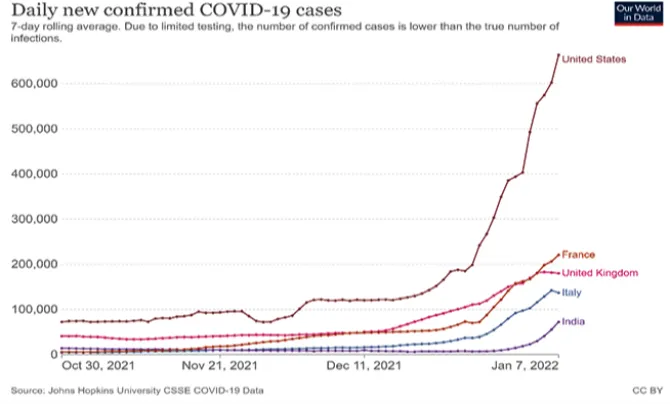
विश्व स्वास्थ्य संगठन ने 26 नवंबर 2021 को कोरोना वायरस के नए वेरिएंट ओमिक्रॉन (B.1.1.529) को चिंताजनक वेरिएंट घोषित किया था, यानी इसका पता लगने के महज़ दो दिनों बाद. कोरोना वायरस के इस वेरिएंट का पहला मरीज़ 9 नवंबर 2021 को दक्षिण अफ्रीका के गौटेंग प्रांत में उस वक़्त मिला था, जब डेल्टा वेरिएंट के बाद संक्रमण में तेज़ी का एक नया दौर देखने को मिला था. 17 दिसंबर 2021 तक इस वेरिएंट के संक्रमण उससे पहले के रिकॉर्ड से भी ज़्यादा ऊंचाई पर पहुंच चुके थे (नीचे देखें)
ब्रिटेन और दक्षिण अफ्रीका, दोनों ही जगहों पर 18 से 39 साल उम्र के लोगों के बीच, ओमिक्रॉन से संक्रमित होने की दर ज़्यादा पायी गई.
Figure 1: दक्षिण अफ्रीका में कोविड-19 महामारी का सफर (Use Original)
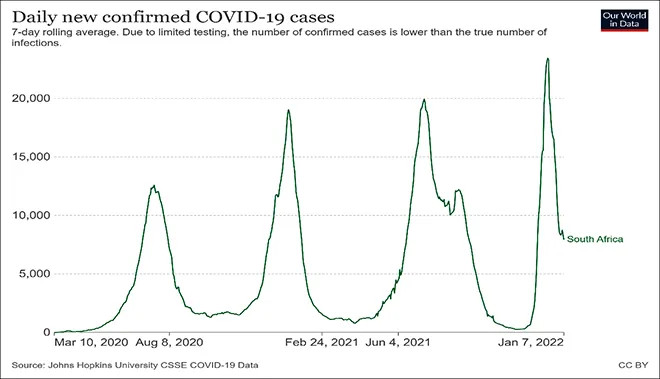
Figure 2: तमाम देशों में ओमिक्रॉन के चलते संक्रमण की शुरुआती बढ़त
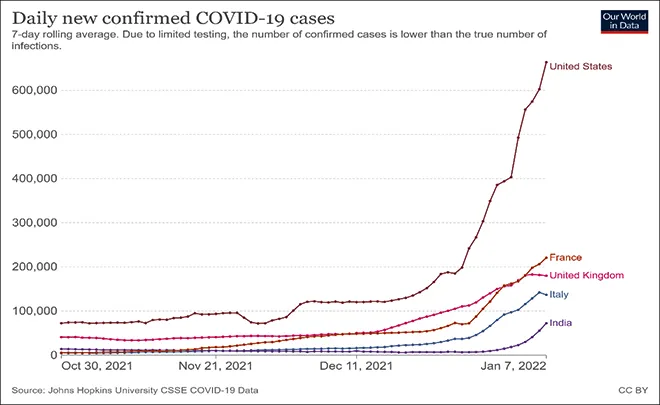
दक्षिण अफ्रीका में महामारी की ये नई लहर जितनी तेज़ी से चढ़ी थी, उतनी ही रफ़्तार से इसमें उतार भी देखा गया. अमेरिका, ब्रिटेन, भारत और फ्रांस जैसे कई और देशों में भी यही मिसाल देखने को मिली है, जहां संक्रमण अभूतपूर्व दर से बढ़े. वैसे तो, विश्व स्वास्थ्य संगठन चेतावनी देता है कि इस वेरिएंट का संक्रमण दो गुना होने में 2 से 3 तीन लगते हैं. लेकिन, इंग्लैंड में हुई एक स्टडी में पाया गया है कि ये दर शायद कम हो. इसके अलावा, डेल्टा वेरिएंट की तुलना में ओमिक्रॉन से दोबारा संक्रमित होने की आशंका, 5.4 गुना अधिक है. इसकी वजह, ओमिक्रॉन का हमारी रोगों से लड़ने की ताक़त (फिर चाहे वो वैक्सीन से आई हो या क़ुदरती तौर पर) को चकमा देने की ख़ूबी है. इसका मतलब ये है कि जो लोग कोरोना के टीके लगवा चुके हैं, उन्हें भी इस वेरिएंट से काफ़ी ख़तरा है. डेनमार्क से मिले आंकड़ों का विश्लेषण करने के बाद कोपेनहेगेन यूनिवर्सिटी ने ज़ोर देकर कहा है कि ओमिक्रॉन वेरिएंट में कई म्यूटेशन हुए हैं और ये डेल्टा की तुलना में कई गुना अधिक संक्रामक है. लेकिन ओमिक्रॉन से संक्रमण के विस्फोट की बड़ी वजह यही है कि ये इम्युनिटी की दीवार को फांदने में सफल हो जाता है.
वैसे तो भारत में संक्रमण की तेज़ रफ़्तार फ्रांस ब्रिटेन और इटली से मिलती-जुलती है. लेकिन अभी भी संक्रमण की तादाद उन देशों से कम ही है. इसकी एक वजह कम टेस्ट और निगरानी हो सकती है.
कोरोना वायरस जैसे RNA वायरस में ये ख़ासियत होती है कि ये धीरे-धीरे बदलते हैं. लेकिन, माना यही जाता है कि कई म्यूटेशन होने और लोगों में इम्यूनिटी विकसित होने के चलते ये वायरस कम घातक हो गया है. ब्रिटेन में हुए अध्ययनों में पाया गया है कि वैक्सीन लेने वालों संक्रमित लोगों के अस्पताल में भर्ती होने की आशंका, बिना वैक्सीन वाले लोगों की तुलना में काफ़ी कम देखी गई है. दक्षिण अफ्रीका में ओमिक्रॉन वेरिएंट पर किए गए शुरुआती रिसर्च में भी ये पाया गया है कि पिछली दो लहरों के दौरान संक्रमित लोगों के बीच जहां अस्पताल में भर्ती होने की दर क्रमश: 60.1 और 66.9 प्रतिशत थी. वहीं, ओमिक्रॉन वेव के दौरान केवल 28.8 प्रतिशत लोगों को ही अस्पताल में भर्ती कराने की ज़रूरत पड़ी. इसके अलावा, अस्पताल में भर्ती कराए गए मरीज़ों में भी 73 फ़ीसद के गंभीर रूप से बीमार पड़ने और संक्रमण के जानलेवा साबित होने की आशंका नहीं थी. ब्रिटेन और दक्षिण अफ्रीका, दोनों ही जगहों पर 18 से 39 साल उम्र के लोगों के बीच, ओमिक्रॉन से संक्रमित होने की दर ज़्यादा पायी गई.
उत्तर प्रदेश, गोवा, उत्तराखंड, पंजाब और मणिपुर में फरवरी मार्च में विधानसभा के चुनाव होने वाले हैं. इसलिए आने वाले समय में राजनीतिक रैलियां और भारी भीड़ वाले कार्यक्रम होंगे. अगर सावधानी न बरती गई, तो इससे संक्रमण की तादाद में बड़ी तेज़ी से इज़ाफ़ा हो सकता है.
Figure 3: तमाम देशों में अस्पताल में भर्ती होने की दर
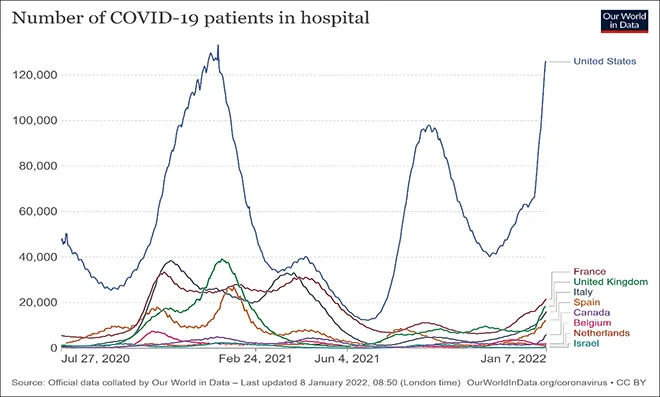
इस ग्राफ में साफ़ दिखता है कि अमेरिका को छोड़ दें, तो पिछली लहरों की तुलना में इस बार फ्रांस, ब्रिटेन, स्पेन, इज़राइल, नीदरलैंड्स, कनाडा और बेल्जियम में ओमिक्रॉन वेरिएंट की लहर के दौरान, मरीज़ों को अस्पताल में भर्ती कराने की ज़रूरत कम पड़ी.
भारत में महामारी की दूसरी लहर, तेज़ तो थी मगर इसने शीर्ष का सफर किस्तों में तय किया था. इसकी तुलना में ओमिक्रॉन वेरिएंट की वजह से आई तीसरी लहर बहुत तेज़ गति से पीक की ओर बढ़ी है. वैसे तो भारत में संक्रमण की तेज़ रफ़्तार फ्रांस ब्रिटेन और इटली से मिलती-जुलती है. लेकिन अभी भी संक्रमण की तादाद उन देशों से कम ही है. इसकी एक वजह कम टेस्ट और निगरानी हो सकती है. क्योंकि, इस वजह से ज़मीनी स्तर पर संक्रमण की वास्तविक स्थिति पकड़ में नहीं आ पाती है.
Figure 4: कोविड-19 की दूसरी और तीसरी लहर के दौरान शुरुआती स्थिति
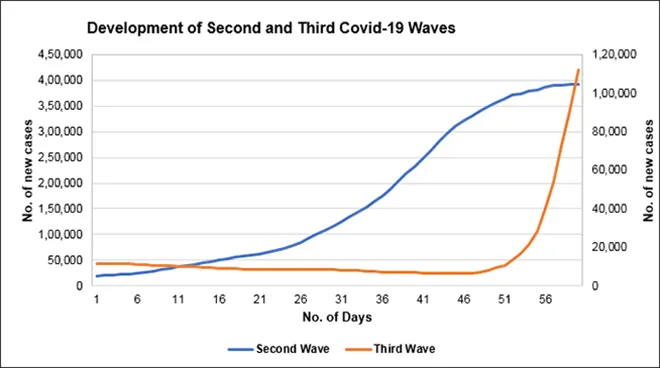
नोट: यहां दूसरी लहर का समय 11 मार्च से 9 मई 2021 के बीच का है. वहीं तीसरी लहर की शुरुआत 11 नवंबर से हुई. आंकड़े 9 जनवरी 2022 तक के हैं.
क्रिसमस से 9 जनवरी 2022 के दौरान भारत में सात दिनों में मिले नए संक्रमण का स्तर और रोज़ की पॉज़िटिविटी दर में लगभग 1600 प्रतिशत का उछाल दर्ज किया गया है. इस स्तर पर स्वास्थ्य से जुड़े अधिकारियों का मानना है कि दिल्ली और मुंबई जैसे हॉटस्पॉट में मिल रहे 80-90 फ़ीसद से ज़्यादा केस ओमिक्रॉन वेरिएंट के ही हैं. हालांकि, जीनोम सीक्वेंसिंग की रिपोर्ट आने में देरी हो रही है.
Figure 5: कोविड-19 का सफर: नए संक्रमण का सात दिनों का औसत और पॉज़िटिविटी दर
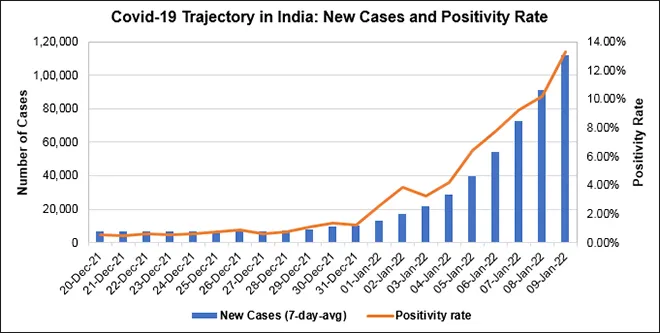
इसके अलावा, ओमिक्रॉन वेरिएंट पर किए गए शुरुआती अध्ययन बताते हैं कि इससे मौत की संख्या पर उतना असर नहीं पड़ा है, जितनी तेज़ नए संक्रमण की दर दिख रही है. इससे ये अनुमान सही साबित हो रहे हैं कि तीसरी लहर के दौरान, संक्रमित लोगों को अस्पताल में भर्ती कराने की ज़रूरत कम पड़ रही है. लेकिन, अस्पताल में भर्ती मरीज़ों की संख्या न बढ़ने का ये मतलब नहीं है कि तीसरी लहर में ज़्यादा लोगों की जान नहीं जा रही है. अगर हम क्रिसमस से 9 जनवरी 2022 तक के आंकड़े देखें, तो महामारी से मौत का सात दिनों का औसत (बैकलॉग को हटाकर) 71 प्रतिशत तक बढ़ गया है. ये इस बात का साफ़ संकेत है कि अगर हम इसकी इजाज़त देंगे, तो ये वायरस लोगों की जान लेता रहेगा. भारत में ओमिक्रॉन वेरिएंट से पहली मौत की ख़बर 5 जनवरी 2022 को राजस्थान से आई थी.
ओमिक्रॉन से संक्रमित लोगों में बीमारी के गंभीर लक्षण भले नहीं दिख रहे हों. लेकिन, ये वेरिएंट वैक्सीन ले चुके लोगों को भी संक्रमित कर रहा है और जिन लोगों ने टीका नहीं लगवाया है, उन्हें तो अस्पताल में भर्ती कराने की ज़रूरत पड़ रही है.
Figure 6: भारत में नए केस और मौत के मामले में कोविड-19 की बढ़त
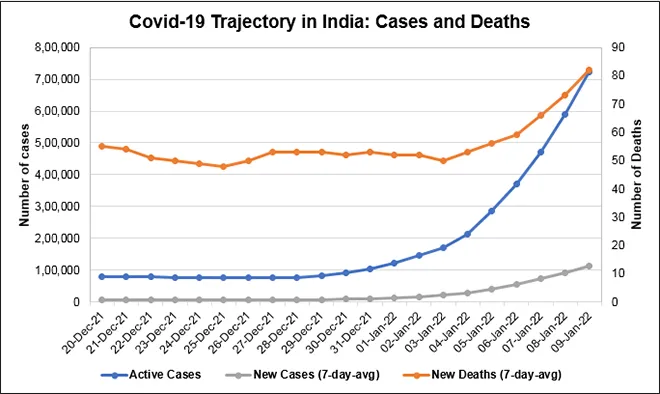
इस वायरस के संक्रमित करने की क्षमता में बढ़ोत्तरी के अलावा भी इससे कुछ और जोखिम हैं, जो हमारी आबादी की स्थिति को कमज़ोर साबित करते हैं. भारत में केवल 65 प्रतिशत लोगों को ही वैक्सीन की दोनों डोज़ लग सकी है. (नीचे देखें). डेनमाक्र, ब्रिटेन, स्पेन और इटली जैसे विकसित देशों की तुलना में ये तादाद बहुत कम है. इस वजह से भी ओमिक्रॉन का संक्रमण काफ़ी तेज़ी से बढ़ा है. टीकाकरण के मामले में देश के बारह राज्य अभी भी राष्ट्रीय औसत का स्तर नहीं हासिल कर सके हैं. पंजाब, नगालैंड और झारखंड इस मामले में सबसे पीछे हैं. इन राज्यों में वयस्क आबादी के पचास प्रतिशत लोगों तक को कोरोना के टीके की दोनों ख़ुराक नहीं लग सकी है. अब तक के सबूत बताते हैं कि एस्ट्राज़ेनेका की वैक्सीन की दो ख़ुराक लेने के बावजूद, कोरोना वायरस के प्रति इम्युनिटी कुछ हफ़्तों में कमज़ोर हो जाती है. ऐसे में हमें ओमिक्रॉन वेरिएंट से निपटने के लिए फ़ौरन ज़रूरी उपाय करने चाहिए, जिससे हम डेल्टा वेरिएंट के दौर वाली दूसरी लहर जैसी तबाही से ख़ुद को बचा सकें.
इसके अलावा, अब जबकि संक्रमण तेज़ी से बढ़ रहा है, तो उसकी तुलना में टेस्टिंग की रफ़्तार नहीं बढ़ाई गई है. महामारी की दूसरी लहर के दौरान एक दिन में बीस लाख तक टेस्ट किए जा रहे थे. जिससे हम स्वास्थ्य व्यवस्था पर डेल्टा वेरिएंट के असर की निगरानी के लिए आंकड़े जुटा सके. लेकिन, 10 जनवरी तक देश में कोरोना टेस्टिंग का औसत हर दिन लगभग 13 लाख के आस-पास ही था. महामारी की तीसरी लहर कैसा असर दिखाएगी, इसे समझने के लिहाज़ से अगले 15 से 30 दिन काफ़ी अहम हैं. इस काम में टेस्टिंग की भूमिका बहुत महत्वपूर्ण होती है. इसके अलावा उत्तर प्रदेश, गोवा, उत्तराखंड, पंजाब और मणिपुर में फरवरी मार्च में विधानसभा के चुनाव होने वाले हैं. इसलिए आने वाले समय में राजनीतिक रैलियां और भारी भीड़ वाले कार्यक्रम होंगे. अगर सावधानी न बरती गई, तो इससे संक्रमण की तादाद में बड़ी तेज़ी से इज़ाफ़ा हो सकता है.
Figure 7: कोरोना की दोनों डोज़ के टीकाकरण का राज्यवार ब्यौरा
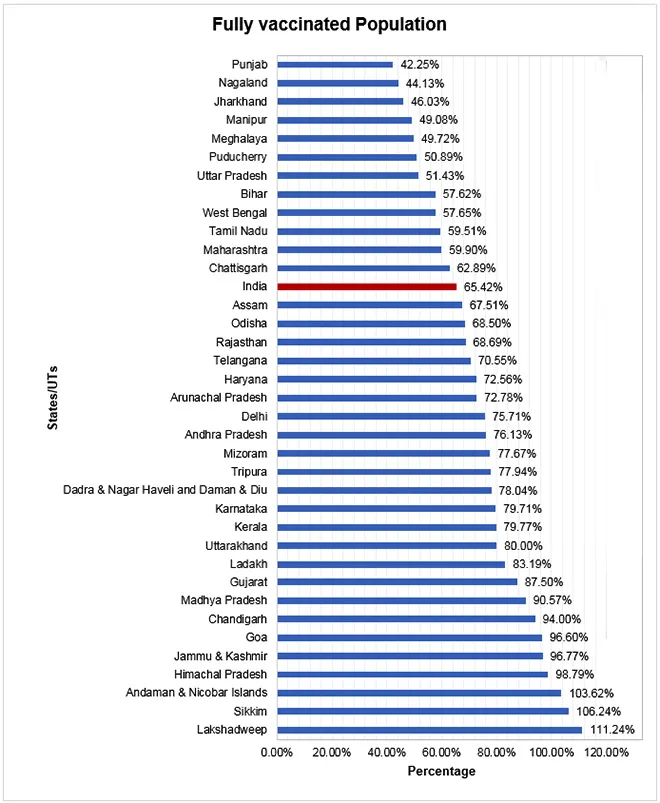
पिछले कुछ हफ़्तों के दौरान, ओमिक्रॉन को एक माइल्ड और जानलेवा नहीं होने वाला वेरिएंट कहने का चलन तेज़ी से बढ़ा है. चूंकि, बहुत से विशेषज्ञ इसे हल्के लक्षणों वाला वेरिएंट कह रहे हैं और सरकारें भी इन तथ्यों पर सवाल नहीं उठा रही हैं. ऐसे में मास्क पहनने जैसे नियमों की अनदेखी की जा रही है. लेकिन इस ग़लत जानकारी पर यक़ीन करने से ख़ुद हमें ही नुक़सान होने वाला है. विश्व स्वास्थ्य संगठन और ओमिक्रॉन की लहर के शुरुआती संकेत बताते हैं कि अगर हम इस तर्क पर यक़ीन करते हैं, तो बहुत बुरा असर पड़ने वाला है. ओमिक्रॉन से संक्रमित लोगों में बीमारी के गंभीर लक्षण भले नहीं दिख रहे हों. लेकिन, ये वेरिएंट वैक्सीन ले चुके लोगों को भी संक्रमित कर रहा है और जिन लोगों ने टीका नहीं लगवाया है, उन्हें तो अस्पताल में भर्ती कराने की ज़रूरत पड़ रही है. इस वेरिएंट से नए तरह के लक्षण सामने आ रहे हैं. इसके संक्रमण की रफ़्तार इतनी तेज़ है कि इसके आगे हमारी स्वास्थ्य व्यवस्था ढह सकती है. भारत में आबादी के एक बड़े हिस्से को टीका लग चुका है. उनके अंदर एंटीबॉडी भी बन चुकी हैं. लेकिन अगर ओमिक्रॉन, कोरोना वायरस का पहला वेरिएंट होता, तो मौत की तादाद कहीं ज़्यादा होती.
यहां इस बात का ख़याल रखने की भी ज़रूरत है कि तीसरी लहर के लिए सबसे अधिक ज़िम्मेदार ओमिक्रॉन वेरिएंट ही है. इसके अलावा, जिन वेरिएंट की पहचान पहले की गई थी, वो भी अभी हमारे बीच मौजूद हैं. चेन्नई और मुंबई में मिले संकेत बताते हैं कि भले ही ओमिक्रॉन और डेल्टा के शिकार मरीज़ ज़्यादा अस्पताल पहुंच रहे हों. लेकिन अभी भी ICU में उन्हीं मरीज़ों की संख्या ज़्यादा है, जो डेल्टा वेरिएंट से संक्रमित हैं. मुंबई, बैंगलुरू और दिल्ली के आंकड़ बताते हैं कि 10 जनवरी 2022 तक अस्पतालों और ICU बेड पर मौजूद मरीज़ों की संख्या क्रमश: 25 और 17 फ़ीसद थी. इसलिए, हमारे ऊपर ख़तरे की दुधारी तलवार लटक रही है. ऐसे में हमें निगरानी को सख़्त करना होगा और 18 साल से कम आबादी के लोगों के टीकाकरण पर ज़ोर देना होगा. क्योंकि, आबादी का ये तबक़ा अभी भी संक्रमण के लिहाज़ से ख़तरे में है.
अगर हम शुरुआती संकेतों पर यक़ीन करें, तो भारत में जल्द ही पहली और दूसरी लहर की तुलना में मरीज़ों की तादाद बढ़ेगी. लेकिन, उनकी तुलना में मौत का आंकड़ा कम रहेगा. शर्त ये है कि हम कोविड के अनुरूप बर्ताव करते रहें. विशेषज्ञ मानते हैं कि तीसरी लहर से निपटने के लिए पूरी तरह लॉकडाउन लगाने जैसे सख़्त उपायों की ज़रूरत नहीं पड़ेगी. लेकिन, स्मार्ट टेस्टिंग, ज़्यादा संक्रमण वाले इलाक़ों की पहचान और उन्हें सीमित करने जैसे उपायों का इस्तेमाल करना उपयोगी होगा.
स्मार्ट टेस्टिंग, ज़्यादा संक्रमण वाले इलाक़ों की पहचान और उन्हें सीमित करने जैसे उपायों का इस्तेमाल करना उपयोगी होगा.
पर, भारत जैसी विशाल आबादी वाले देश के लिए मौजूदा लहर का बुरा असर पड़ना लाज़मी है. अस्पतालों पर बोझ बढ़ेगा. इससे दवाओं की जमाखोरी बढ़ने का डर है, क्योंकि मरीज़ बढ़ेंगे तो ऑक्सीजन की मांग भी बढ़ेगी. इन सब बातों से लोगों में भय का माहौल बनने का डर है. ऐसे में प्राथमिक टीकाकरण को रफ़्तार दिए जाने की ज़रूरत है, जिससे हम तीसरी लहर के बुरे असर से बट सकें. इसके अलावा ज़्यादा जोखिम वाले लोगों को बूस्टर डोज़ देने की रफ़्तार भी तेज़ करनी होगी. आने वाले समय में हम इस वायरस के नए नए वेरिएंट सामने आते देखेंगे. हमें कोविड अनुरूप बर्ताव करके ख़ुद को ऐसे हालात के लिए हमेशा तैयार रखना चाहिए, न कि भय और ग़लत जानकारी का शिकार होना चाहिए. एक अच्छी बात ये है कि देश की आबादी के एक बड़े तबक़े में एंटीबॉडी बनने से मरीज़ों के गंभीर रूप से बीमार होने और उनको अस्पताल में भर्ती कराने की ज़रूरत कम पड़ रही है. इसके बावजूद, हमें याद रखना होगा कि ये वही वायरस है जो दुनिया भर में पचास लाख से ज़्यादा लोगों की जान ले चुका है. इसे कम करके आंकना या फिर कोई लापरवाही करना ख़ुद अपने ऊपर तबाही बुलाने जैसा होगा.
ओआरएफ हिन्दी के साथ अब आप Facebook, Twitter के माध्यम से भी जुड़ सकते हैं. नए अपडेट के लिए ट्विटर और फेसबुक पर हमें फॉलो करें और हमारे YouTube चैनल को सब्सक्राइब करना न भूलें. हमारी आधिकारिक मेल आईडी orfhindi@orfonline.org के माध्यम से आप संपर्क कर सकते हैं.
The views expressed above belong to the author(s). ORF research and analyses now available on Telegram! Click here to access our curated content — blogs, longforms and interviews.

Mona is a Junior Fellow with the Health Initiative at Observer Research Foundation’s Delhi office. Her research expertise and interests lie broadly at the intersection ...
Read More +